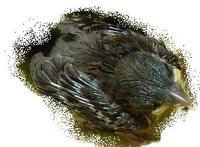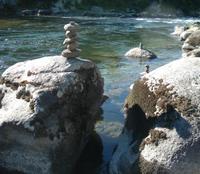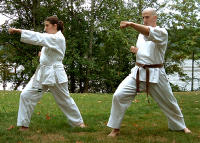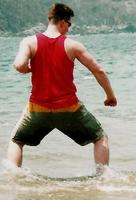Why karate ranch? What's with all the rock stacking? Where is this all going?
karate - doFor fourteen years I have been involved in the martial arts. I have had the pleasure of practicing kyokushin karate, goju ryu karate, and aikido. Sometime during my practice of goju ryu karate I discovered that there were people who were "doing" karate. Not making life changes, not studying the mental and spiritual aspects of the martial arts, just
doing karate. My first clue that this was going on were those people who would come to class and do nothing but talk about golf and how great it was. Then, a bomb dropped.
As I have always been interested in
kumite (sparring) with people from various styles, I accepted lots of matches from people studying things I had never heard of before. During one match, it became apparent that my sparring partner had never actually hit anything. Further, that they had never actually learned to stand or kick or anything for that matter. It was later revealed to me that this person had been "studying" from a fitness video.
Fast forward to years later when during my internship to receive my
shodan the instructor quit and became a pacifist. I was left with the choice of looking for another school or teaching the little that I knew. That is where I am today, the only link to goju ryu karate that my students have. The importance of passing on the art has certainly dawned on me as well as the fact that without teachers, the martial arts are little more than a fitness fad.
Ranchers of the WaySo what does a ranch have to do with the martial arts? In simple enough terms, I feel that karate students go through three phases:
1)
Dependent. Everything is new to the dependent student. They may feel shy or awkward performing the various karate moves and trip up a lot on karate terminology.
2)
Co-dependent. The student knows quite a bit about the martial arts, has reached a level of comprehension that allows them to do workouts in groups without the teacher standing directly over them. Students are able to work together to answer questions that they have about different kata, karate moves, and are even able to study philosophy, tactics, and complex or advanced karate moves that they haven't been shown yet.
3)
Independent. The student has learned all the basic karate moves, knows enough karate terminology to teach it to others and is self-correcting. The independent student needs little to no motivation from others and if left unchecked will become a living symbol of the
Way.This is similar to the care of animals. When an animal is born, it is dependent completely on others for survival. As it grows older it learns from experience how to get around, how to find food, et cetera. Finally, when an animal is old enough, it will be able to complete complex tasks, find its own food and be able to rear young.
A
dojo, then, can be likened to a ranch. You have a community of individuals, all at different levels, working together to achieve a common goal. The only problem is that a
dojo is rarely a place where twenty four hour a day practice is a reality. Often, martial artists will go on retreats to improve their skills, but usually are only competent enough to do that alone when they have reached the "independent" stage. This leaves the vast majority of students with no intensive training programs to take up.
Karate Ranch: DreamMy end goal, then, is to have a school where students can "get away from it all" to an intense training camp. Students may spend two weeks there in the summer and practice ten to fourteen hours a day. Activities would include: conditioning, meditation, kata, kumite, classes on the history of martial arts, martial arts terminology, open workshops devoted to the mind-set and philosophy of the martial arts, comparative studies and breaking things.
While the training may seem intense, it would be broken up into phases. The first phase would be orientation. Students would get to know the karate ranch and the people involved. They would get to know each other a lot better. They would learn where and when classes were and of course, where to go to the bathroom! This phase would probably last the first day as students got settled in.
The second phase would involve getting the students physically and mentally ready to learn. Brisk morning jogs, stretching, weight-lifting, stance work (including lots of moving and standing basics), and learning karate moves.
Third phase would be at least partially composed of standing and moving basics. get each student to a level of basic understanding and comfort with the martial arts.
At each training level, there would be an evaluation to assure that the student was making progress. At the end, there would be an final exam covering everything learned and an extensive diagnostic of the physical, mental and spiritual condition of the participant. In this way, a student would be able to properly judge their own progress and know what to work for. Also, they would feel a part of a larger community.









